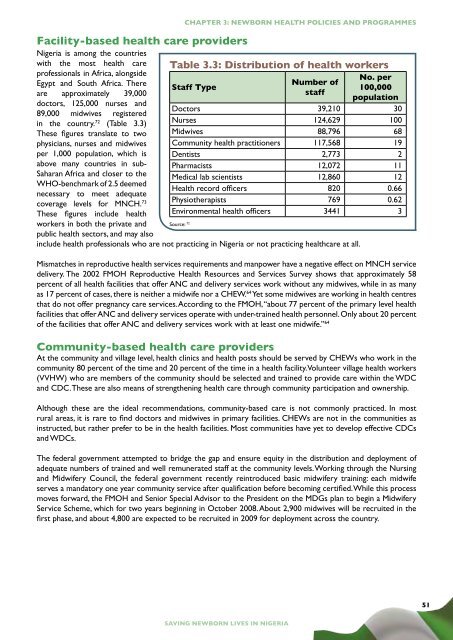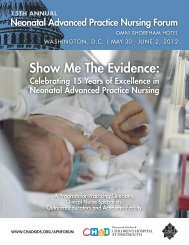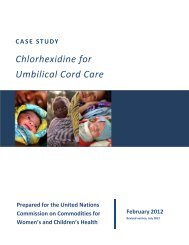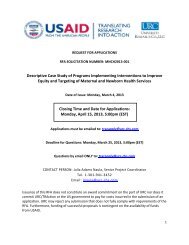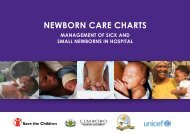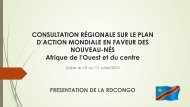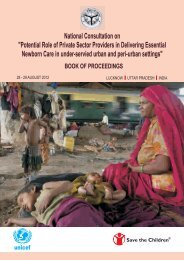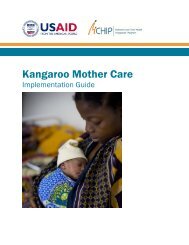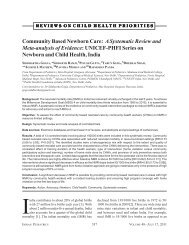situation action plan - nigeria.pdf - Healthy Newborn Network
situation action plan - nigeria.pdf - Healthy Newborn Network
situation action plan - nigeria.pdf - Healthy Newborn Network
- No tags were found...
Create successful ePaper yourself
Turn your PDF publications into a flip-book with our unique Google optimized e-Paper software.
Facility-based health care providersNigeria is among the countriesCHAPTER 3: NEWBORN HEALTH POLICIES AND PROGRAMMESTable 3.3: Distribution of health workerswith the most health careprofessionals in Africa, alongsideNo. perEgypt and South Africa. ThereNumber ofStaff Type100,000are approximately 39,000staffpopulationdoctors, 125,000 nurses andDoctors 39,210 3089,000 midwives registeredin the country. 72 (Table 3.3)Nurses 124,629 100These figures translate to two Midwives 88,796 68physicians, nurses and midwivesper 1,000 population, which isCommunity health practitionersDentists117,5682,773192above many countries in sub- Pharmacists 12,072 11Saharan Africa and closer to the Medical lab scientists 12,860 12WHO-benchmark of 2.5 deemedHealth record officers 820 0.66necessary to meet adequatecoverage levels for MNCH. 73 Physiotherapists 769 0.62These figures include health Environmental health officers 3441 3workers in both the private and Source: 72public health sectors, and may alsoinclude health professionals who are not practicing in Nigeria or not practicing healthcare at all.Mismatches in reproductive health services requirements and manpower have a negative effect on MNCH servicedelivery. The 2002 FMOH Reproductive Health Resources and Services Survey shows that approximately 58percent of all health facilities that offer ANC and delivery services work without any midwives, while in as manyas 17 percent of cases, there is neither a midwife nor a CHEW. 64 Yet some midwives are working in health centresthat do not offer pregnancy care services. According to the FMOH, “about 77 percent of the primary level healthfacilities that offer ANC and delivery services operate with under-trained health personnel. Only about 20 percentof the facilities that offer ANC and delivery services work with at least one midwife.” 64Community-based health care providersAt the community and village level, health clinics and health posts should be served by CHEWs who work in thecommunity 80 percent of the time and 20 percent of the time in a health facility. Volunteer village health workers(VVHW) who are members of the community should be selected and trained to provide care within the WDCand CDC. These are also means of strengthening health care through community participation and ownership.Although these are the ideal recommendations, community-based care is not commonly practiced. In mostrural areas, it is rare to find doctors and midwives in primary facilities. CHEWs are not in the communities asinstructed, but rather prefer to be in the health facilities. Most communities have yet to develop effective CDCsand WDCs.The federal government attempted to bridge the gap and ensure equity in the distribution and deployment ofadequate numbers of trained and well remunerated staff at the community levels. Working through the Nursingand Midwifery Council, the federal government recently reintroduced basic midwifery training: each midwifeserves a mandatory one year community service after qualification before becoming certified. While this processmoves forward, the FMOH and Senior Special Advisor to the President on the MDGs <strong>plan</strong> to begin a MidwiferyService Scheme, which for two years beginning in October 2008. About 2,900 midwives will be recruited in thefirst phase, and about 4,800 are expected to be recruited in 2009 for deployment across the country.51SAVING NEWBORN LIVES IN NIGERIA


